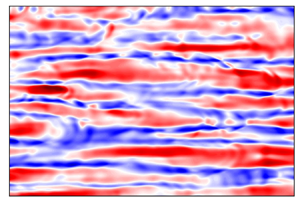Published online by Cambridge University Press: 07 November 2023

The wall cooling effect on the spectra and structures of thermodynamic variables are investigated in hypersonic turbulent boundary layers. The density and temperature can be divided into the acoustic and entropic modes based on the Kovasznay decomposition. The intensities of the pressure and the acoustic modes of density and temperature attain the maximum values near the wall, while those of the entropy and the entropic modes of density and temperature achieve their primary peaks near the edge of the boundary layer. In the near-wall region, the pressure and the acoustic modes of density and temperature are significantly enhanced when the wall is strongly cooled, which can be attributed to the appearance of the travelling-wave-like alternating positive and negative structures. Moreover, the intensities of the entropy and the entropic modes of density and temperature become stronger near the wall as the wall temperature decreases, due to the appearance of the streaky entropic structures (SES). The SES are mainly caused by the advection effect of the strong positive wall-normal gradient of the mean temperature associated with ejection and sweep events. It is also found that the profiles of the intensities of the entropy, density and temperature are similar to each other far from the wall, which is mainly due to the reason that the entropic modes are dominant in the fluctuating density and temperature in the far-wall region. The acoustic modes of density and temperature only have significant contributions in the near-wall region.